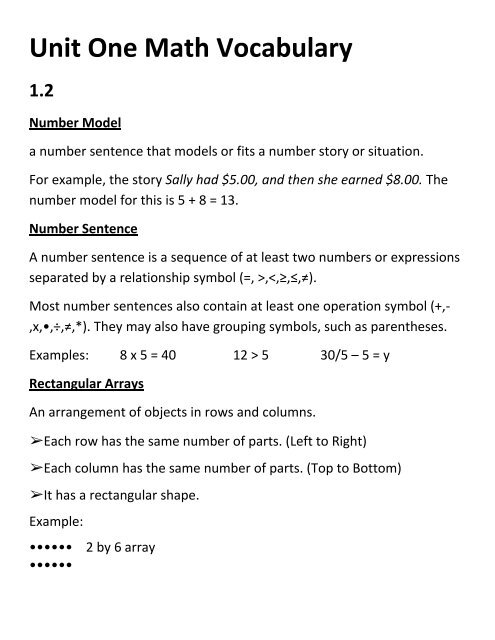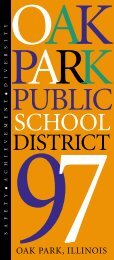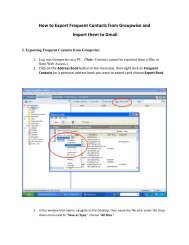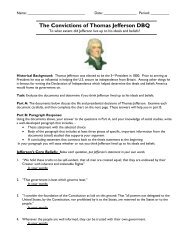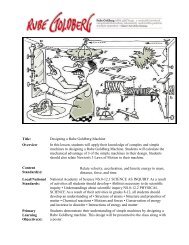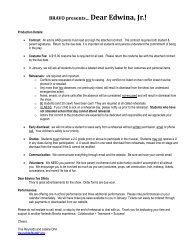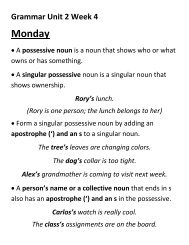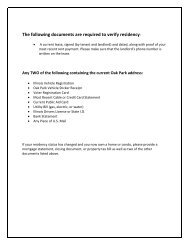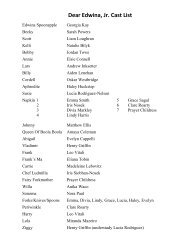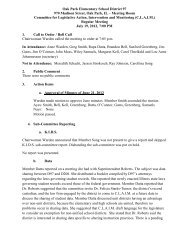Unit One Math Vocabulary
Unit One Math Vocabulary
Unit One Math Vocabulary
Create successful ePaper yourself
Turn your PDF publications into a flip-book with our unique Google optimized e-Paper software.
<strong>Unit</strong> <strong>One</strong> <strong>Math</strong> <strong>Vocabulary</strong><br />
1.2<br />
Number Model<br />
a number sentence that models or fits a number story or situation.<br />
For example, the story Sally had $5.00, and then she earned $8.00. The<br />
number model for this is 5 + 8 = 13.<br />
Number Sentence<br />
A number sentence is a sequence of at least two numbers or expressions<br />
separated by a relationship symbol (=, >, 5 30/5 – 5 = y<br />
Rectangular Arrays<br />
An arrangement of objects in rows and columns.<br />
➢Each row has the same number of parts. (Left to Right)<br />
➢Each column has the same number of parts. (Top to Bottom)<br />
➢It has a rectangular shape.<br />
Example:<br />
••••••<br />
••••••<br />
2 by 6 array
Turn-Around Rule (Commutative Property for Multiplication)<br />
A property of addition and multiplication (not division and subtraction)j<br />
that says that changing the order of the numbers being added or<br />
multiplied doesn’t change the answer.<br />
Examples: 5 + 10 = 15 and 10 + 5 = 15<br />
5 x 6 = 30 and 6 x 5 = 30<br />
1.3<br />
Factor<br />
<strong>One</strong> of two or more numbers that are multiplied to give a product. The<br />
numbers that are multiplied are called factors of the product.<br />
Example 4 and 3 are factors of 12, because 4 x 3 = 12<br />
Product<br />
The result of multiplying two numbers called factors.<br />
Example In 4 x 3 = 12, the product is 12.<br />
Factor Pair<br />
Two whole-number factors of a number whose product is the number. A<br />
number may have more than one factor pair.<br />
Example The factor pairs for 18 are 1 and 18, 2 and 9, and 3 and 6.
Factor Rainbows<br />
A way to show factor pairs in a list of all the factors of a number. A factor<br />
rainbow can be used to check whether a list of factors is correct.<br />
Example The factors of 24 are: 1 2 3 4 6 8 12 24<br />
1.4<br />
Even Number<br />
A whole number that can be divided by 2 with no remainder is an even<br />
number.<br />
Example Even Numbers are 2, 4, 6, 8, and so on. 0 may be<br />
considered even.<br />
Odd Number<br />
A whole number such as 1, 3, 5, and so on, that cannot be evenly divided<br />
by 2. When an odd number is divided by 2, there is a remainder of 1.<br />
Example<br />
The odd numbers are 1, 2, 5, 7, 9, and so on.<br />
Remainder<br />
An amount left over when one number is divided by another number.<br />
Example If you divide 38 by 5, you get 7 with a remainder of 3.
Divisible by<br />
<strong>One</strong> whole number is divisible by another whole number if there is no<br />
remainder when you divide.<br />
Example<br />
28 is divisible by 7 because 28 divided by 7 is 4 with a<br />
remainder of 0.<br />
1.5<br />
Quotient<br />
The result of dividing one number by another number.<br />
Example In 35 ÷ 5 = 7 the quotient is 7.<br />
Divisibility Test<br />
A test to find out whether a whole number is divisibly by another whole<br />
number without actually doing the division.<br />
Example A divisibility test for 5 is to check the last digit: if the last digit is<br />
0 or 5, then the number is divisible by 5.<br />
1.6<br />
Composite Number<br />
A whole number that has more than two factors.<br />
Example 4 is a composite number because it has three factors: 1, 2,<br />
and 4.
Prime Number<br />
A whole number that has exactly two factors: itself and 1.<br />
Example 5 is a prime number because its only factors are 5 and 1.<br />
1.7<br />
Square Array<br />
An array that has the same number of rows and columns.<br />
Example<br />
A 4 by 4 array is a square array.<br />
Square Number<br />
A number that is the product of a counting number multiplied by itself.<br />
Example 25 is a square number because 25 = 5 x 5.<br />
The square numbers are 1, 4, 9, 16, 25, and so on.<br />
Exponential Notation<br />
A way to show repeated multiplication by the same factor.<br />
Example 2 3 is exponential notation for 2 x 2 x 2. It tells how many times<br />
the number 2, called the base, is used as a factor.<br />
Exponent Key ^<br />
This is the key that is used on your calculator to show exponents.
Exponent<br />
A small, raised number in exponential notation that tells how many times<br />
the base is to be multiplied by itself.<br />
Example In 5 3 the exponent is 3.<br />
1.8<br />
“Unsquaring” a Number<br />
The same as undoing the result of squaring a number.<br />
Example You can use several methods to unsquare a number. You<br />
can use the random method, the “squeeze” method, or the endings and<br />
products method.<br />
Square Root<br />
The square root of a number n is a number which, when multiplied by<br />
itself, gives the number n.<br />
Example 4 is the square root of 16 because 4 x 4 = 16.<br />
Square-Root Key √<br />
The key on the calculator that finds the square root of a number for you.
1.9<br />
Name-Collection Box<br />
A diagram that is used for writing equivalent names for a number.<br />
Factor String<br />
A number written as a product of at least two whole-number factors.<br />
Example A factor string for the number 24 is 2 x 3 x 4. This factor string<br />
has three factors, so its length is 3. The number 1 is never part of a factor<br />
string.<br />
Length of Factor String<br />
The number of factors a factor string has is its length.<br />
Example Another factor string for 24 is 3 x 8. This factor string has<br />
two factors, so its length is 2.<br />
Prime Factorization<br />
A whole number expressed as a product of prime factors. Every whole<br />
number greater than 1 has a unique prime factorization.<br />
Example The prime factorization of 24 is 2 x 2 x 2 x 3.


